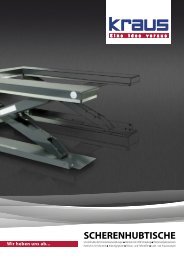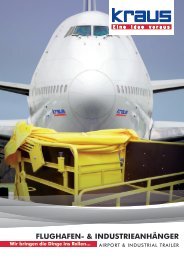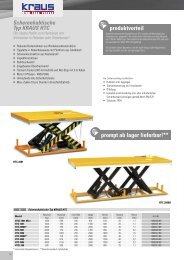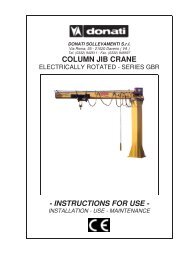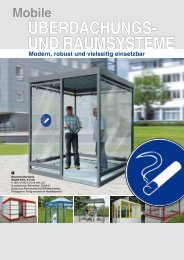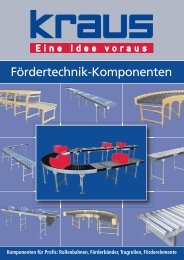JIB CRANES WITH AN ARTICULATED ARM MANUALLY ROTATED
JIB CRANES WITH AN ARTICULATED ARM MANUALLY ROTATED
JIB CRANES WITH AN ARTICULATED ARM MANUALLY ROTATED
Create successful ePaper yourself
Turn your PDF publications into a flip-book with our unique Google optimized e-Paper software.
DONATI SOLLEVAMENTI S.r.l. - Via Roma, 55 - 21020 Daverio (VA) - Tel. 0332 942611 - Fax. 0332 948597<br />
5.2.6 Manoeuvres: lifting and arm rotation<br />
§ It is a good rule to perform one movement at a time, because only in this way can a manoeuvre be<br />
started, stopped and constantly followed by the operator, who also has to avoid continuously switching the<br />
machine on and off even for little movements.<br />
• Engagement of the load by the hook of the hoist and by the lifting accessories must be carried out with<br />
great care, delicately and without jolting.<br />
• Begin a lifting operation by slowly stretching the chain until the load has been lifted by a few<br />
centimetres, stop the manoeuvre and check the hold and stability of the load.<br />
• At the end of the manoeuvre, place the load on the ground carefully and remove the hook of the hoist.<br />
• During lifting manoeuvres the operator must avoid resting the hook on the ground or on loads to be<br />
lifted, to avoid free oscillation of the chain. The operator must absolutely avoid making skew falls with<br />
the chain, which are always dangerous and difficult to control ( fig.53 ).<br />
• During manual rotation manoeuvres of the arm the operator must handle the load by pushing it and<br />
never by pulling it towards himself, to avoid the risk of crushing ( fig.54 ).<br />
5.2.7 Safety devices<br />
• Operate with care and diligence, follow the manoeuvre constantly and<br />
visually check the balance of the mass being moved.<br />
• Avoid sharp or jolting movements which are very damaging to the stability<br />
of the load because of the dynamic effects which are generated.<br />
• Never lift loads with an unbalanced and non barycentric engagement. Never<br />
neglect to hook the load and secure all original sling accessories. Do not<br />
secure the load with improvised slinging.<br />
• Never leave the load suspended, once the handling operation has begun it<br />
must be completed in the shortest time possible and the load must be<br />
positioned without crushing the lifting accessories<br />
fig.53<br />
41<br />
fig.54<br />
§ Cutting out the power supply of the crane must be done by switching off the line switch/selector (not<br />
included in the supply) and/or by pushing the “emergency stop” button on the push-button panel.<br />
§ An electric and/or mechanical lock prevents simultaneous use of commands for the two directions of the<br />
motors for both high and low speeds.<br />
§ A lack of voltage causes all movements of the hoist to be stopped immediately, as the motors are<br />
equipped with an automatic braking device.<br />
§ A safety latch is installed on the lifting hook to prevent accidental unhooking of the slinging and/or load.<br />
§ The lifting, and rotation limit switches bound the maximum vertical and horizontal travel of the load. They<br />
are emergency devices and are not suitable for turning off the machine or to begin new operations.<br />
•When the safety devices are not supplied by DONATI SOLLEVAMENTI<br />
S.r.l., they must be installed by the purchaser.<br />
•Use of the jib crane and/or application of the CE marque, shown here<br />
on the right, is forbidden before the crane has been completed<br />
according to the specifications detailed in this point.



